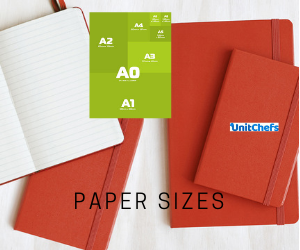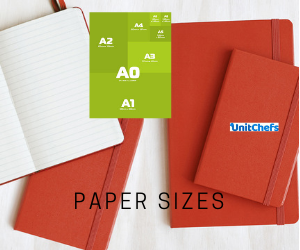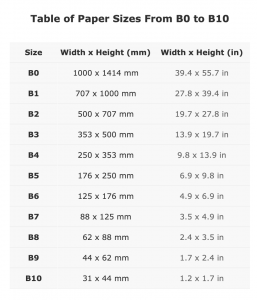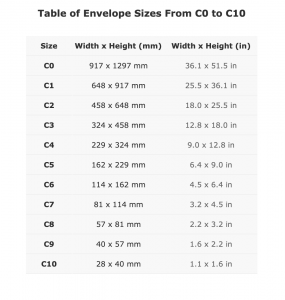
Different Paper Size Standards and Their Dimensions
The international standard ISO 216 defines paper sizes used in most countries of the world except for Canada, the United States, Mexico, and Colombia. This paper measurement standard specifies the “A” and “B” series of paper sizes with the most commonly used paper size worldwide being A4, measuring 210 by 297 millimeters (8.27 in × 11.7 in).

The supplementary ISO 269 “C” series is used for envelopes to match the A-series paper. The area of C series sheets is the geometric mean of the areas of the A and B series sheets of the same number; for instance, the area of a C4 sheet is the geometric mean of the areas of an A4 sheet and a B4 sheet. This means that C4 is a little larger than A4 and smaller than B4.
Another additional format is The ISO 217 standard which describes the RA and SRA paper formats which represent untrimmed raw paper. RA stands for “raw format A,” and SRA stands for “supplementary raw format A.” The RA and SRA formats are somewhat bigger than the corresponding A-series sizes. This allows bleed (ink to the edge) on printed material that will be later cut down to size. These paper sheets, after printing and binding be, are cut to match the A format.
The ISO A0 format has an area of 1.00 m²
The ISO RA0 format has an area of 1.05 m²
The ISO SRA0 format has an area of 1.15 m²
The A series was adopted in Europe in the 19th century. It uses an aspect ratio of 1:√2, which is a significant advantage because of its scaling. If a sheet with an aspect ratio of √2 is divided into two halves parallel to its shortest sides, then the halves also have the aspect ratio of √2. Successive paper sizes in the series A1, A2, A3, and so on, are defined by halving the other paper size across the larger dimension. This also effectively halves the area of each sheet. For example, cutting an A4 sheet in half will create two A5 sheets. The most massive sheet from the A series is the A0 size which has an area of 1m2, and dimensions -841mm x 1189mm.
A paper sizes
| Size | Width x Height (mm) | Width x Height (in) |
|---|---|---|
| A0 | 841 x 1189 mm | 33.1 x 46.8 in |
| A1 | 594 x 841 mm | 23.4 x 33.1 in |
| A2 | 420 x 594 mm | 16.5 x 23.4 in |
| A3 | 297 x 420 mm | 11.7 x 16.5 in |
| A4 | 210 x 297 mm | 8.3 x 11.7 in |
| A5 | 148 x 210 mm | 5.8 x 8.3 in |
| A6 | 105 x 148 mm | 4.1 x 5.8 in |
| A7 | 74 x 105 mm | 2.9 x 4.1 in |
| A8 | 52 x 74 mm | 2.0 x 2.9 in |
| A9 | 37 x 52 mm | 1.5 x 2.0 in |
| A10 | 26 x 37 mm | 1.0 x 1.5 in |
Although not as widely used as the A standards, The B series of measures are also quite popular, and they were created to provide a variety of paper sizes that the A series did not comprise. B1 is between A0 and A1 in format.

Here’s also C-series envelope sizes:

The most common standards for paper sizes in the United States sizes are called Letter, Legal, and Ledger/Tabloid.
The American National Standards Institute (ANSI) adopted ANSI/ASME Y14.1, which outlined a series of paper sizes in 1996, based on the standard 8.5 inches x 11 inches (216mm x 279mm) Letter size, which was named ‘ANSI A.’ Similarly to the ISO standard, when you cut a sheet in half, you will have two sheets of the next smaller size. Ledger/Tabloid is known as ‘ANSI B.’ The scaling of Us paper sizes is more complicated.
US paper sizes
| Size | Width x Height (mm) | Width x Height (in) |
|---|---|---|
| Half Letter | 140 x 216 mm | 5.5 x 8.5 in |
| Letter | 216 x 279 mm | 8.5 x 11.0 in |
| Legal | 216 x 356 mm | 8.5 x 14.0 in |
| Junior Legal | 127 x 203 mm | 5.0 x 8.0 in |
| Ledger / Tabloid | 279 x 432 mm | 11.0 x 17.0 in |